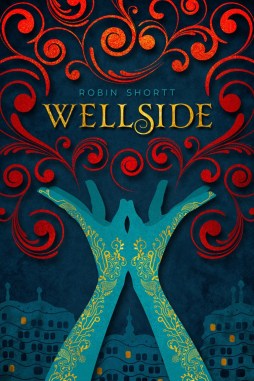I’ve been thinking a lot about story touchstones lately, starting with Sapsorrow’s Dress. As well as exploring some more of my own imaginative touchstones, I decided to ask a bunch of other writers about theirs. This week I’ve invited my good friend Robin Shortt, author of the soon-to-be-released YA novel Wellside, to share a key source of his storytelling inspiration. I gave him a bunch of questions, but I’m just going to throw them away at this point, because Robin’s story is fasincating…
(And because he’s too modest to boast, I’m going to say that you should watch out for Wellside, because it is A. May. Zing. I beta-read an early draft and it’s one of the best things I’ve ever read.)
Back in the mid-Eighties, what got me through a lot of boring days in sweltering classrooms was the knowledge that once they let me out I could go home, turn the fan on, turn the TV on and hear this:
In the worlds before Monkey, primal chaos reigned. Heaven sought order…but the phoenix can fly only when its feathers are grown. The four worlds formed again and yet again, as endless aeons wheeled and passed. Time and the pure essences of Heaven, the moisture of Earth, the powers of the sun and the moon all worked upon a certain rock, old as creation; and it became magically fertile. That first egg was named “Thought”. Tathāgata Buddha, the Father Buddha, said: “With our thoughts, we make the world.” Elemental forces caused the egg to hatch. From it then came a stone monkey. The nature of Monkey was irrepressible!
(Cue Seventies J-Rock).
https://www.youtube.com/watch?v=K2huJqFsFDE&t=19s
Monkey was (deep breath) a BBC dub of a Japanese adaptation of the Ming Dynasty Chinese novel Journey to the West, which was in turn based on Song Dynasty legends surrounding Tang Dynasty Buddhist monk Xuanzang (or Sanzang, or Tripitaka) and his pilgrimage to India.
In both the novel and the show, Tripitaka is only a supporting character. The protagonist is the stone monkey we just saw in the intro—Sun Wukong, the Monkey King, an even older figure in Chinese folklore, who becomes Tripitaka’s chief disciple. Together they journey from China to India so they can bring back original Buddhist scriptures. And, every episode, Monkey has to fend off assorted brigands, goblins and demons who try to waylay our heroes, in some kickass tokusatsu-style fight scenes.
It would almost be easier to talk about what isn’t a touchstone for me here. I like my heroes to question authority, and you won’t find a better anti-authoritarian fantasy than Monkey, who gatecrashes Heaven, mocks the Jade Emperor, steals the Peaches of Immortality from under his nose, and proceeds to beat up pretty much every major figure in Chinese mythology, with only the direct intervention of Buddha slowing him down. He’s a great character who still makes his presence felt in pop culture today, notably as the direct inspiration for Dragonball’s Goku. It was also my first exposure to East Asian martial arts and fight choreography, which I immediately fell in love with—I don’t think I’ve written a fight scene yet without some Monkey in its DNA.
Also—and this is what I want to talk about here—it was full of mythology and theology, starting with the dense Creation-story in the intro, that I knew literally nothing about. In Australian schools of the Eighties, when Religious Education consisted of a visit from a Protestant with an acoustic guitar and a felt board, Buddhism (let alone Taoism) was not exactly on the cultural radar. All this stuff was completely new to me, a vast and complex cosmology that was often only dropped as tantalizing hints, since the show always had to keep moving to the next scene of Monkey beating the shit out of a luckless demon with his magical staff. The culture, the society, even the landscape and architecture in the show, all of it was new.
This is probably a good time to mention the cultural appropriation angle. Monkey is an absolute minefield of appropriation issues—even before we get to the English dub, Japan’s borrowing of Chinese culture is an entire field of study in its own right. Then there’s China’s historical appropriation of Buddhism, which you can see in the syncretism of the novel’s vision of Heaven, where Buddha rubs shoulders with Laozi and the Jade Emperor.
There’s a lot in the dub that (rightly) wouldn’t fly these days—the Chinese-takeaway typeface of the title, the Asian accents put on by the mostly white cast. Back then, though, when Doctor Who was literally casting white dudes in yellowface as Asian characters, it didn’t stand out. Most importantly, their hearts were in the right place. While the dub, written by David Weir, could get silly (and the Japanese series was very silly at times), the underlying Buddhist and Taoist ideas were serious—Monkey itself is an extended Buddhist parable—and they were treated seriously. And while the show’s original Japanese audience would have been a lot more familiar with this world and its characters, the dub had to introduce them to kids for whom they were entirely new, without getting in the way of the story. They succeeded brilliantly.
(Digression: it helped that the source material, and the literary tradition it belonged to, was massively entertaining in its own right. Of Chinese literature’s Four Great Classical Novels, three of them (Journey to the West, Romance of the Three Kingdoms, and The Water Margin) are pretty much straight-up adventure stories and compulsively readable. They even have cliffhangers:
The Jade Emperor accordingly told the demon-king Mahabali and a contingent of heavenly troops to hoist Monkey up and bring him to the executioner’s block, where he was to be cut into small pieces.
If you do not know what now became of this Monkey King, listen to what is told in the next chapter.
It’s the literary tradition that ended up giving us wuxia and Jin Yong, probably the best writer of adventure fiction in the history of the world, and who deserves a blog post or several in his own right. End digression.)
This trick—to introduce an unfamiliar world while also telling a readable story—is hard to pull off. We’ve all read stories that get bogged down in world-building, spending pages and pages on lovingly-detailed backstory while nothing at all happens; or stories that move along pleasantly enough but where the background is threadbare at best, or at worst just copy-pastes elves and dwarves from Tolkein at second- or third-hand.
All the fiction I’ve loved since I was a kid has managed this trick—H.P. Lovecraft, Tanith Lee, Michael Moorcock, Zack Parsons. Now, probably foolishly, I’m trying it myself. My upcoming novel Wellside is set in the Well, an endless pit lined with doors that each open onto a different world—a hub of realities, owing something to King’s Dark Tower and Blyton’s Faraway Tree. Various worlds have attempted to colonize the Well, sometimes cooperating with each other, sometimes butting heads.
The setting itself isn’t influenced by Chinese mythology (although watching the intro again after so many years, I can see the mountains of mud from which Monkey’s egg hatches in the skyline of Wellside’s Red Sand City) but it’s a complex background that I’ve tried to sketch out without bogging down the story. I hope I’ve at least partially succeeded.

Robin was born in Canberra and lives in Vancouver. His stories have previously appeared in Andromeda Spaceways Inflight Magazine and the Canberra Speculative Fiction Guild anthology Winds of Change. Wellside, his debut novel, out from Candlemark and Gleam in June 2017, is a tour de force of subgenre fusion that just cries out to become an immersive movie directed by someone with the visual flair of Peter Jackson or Guillermo del Toro.

Pingback: Doors into Amazing Worlds: Wellside by Robin Shortt | Candlemark & Gleam